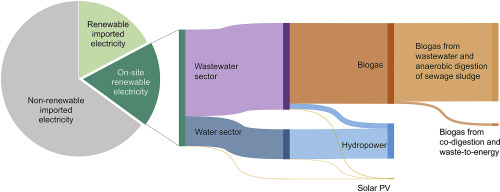Journal of Cleaner Production ( IF 11.1 ) Pub Date : 2020-01-13 , DOI: 10.1016/j.jclepro.2020.120119 A. Strazzabosco , S.J. Kenway , P.A. Lant

|
Water and wastewater utilities have increasingly invested in on-site renewable electricity generation to address rising energy costs, reduce greenhouse gas emissions and meet renewable energy targets. Yet, the extent to which renewable electricity sources are currently adopted by these utilities is unknown. This work quantifies the current level of renewable electricity generated by Australian water and wastewater utilities, the renewable electricity sources adopted, and their overall contribution to the total water industry electricity generation. In 2018, the Australian water industry generated 18% (279 GWh/y) of its electricity demand from on-site renewable electricity sources. Biogas from anaerobic digestion of wastewater and sewage sludge accounted for 67% (187 GWh/y) of the electricity generated, followed by hydropower (30%, 84 GWh/y), biogas from co-digestion and waste-to-energy through anaerobic digestion of organic feedstock (2%, 5.5 GWh/y), and solar photovoltaic (1%, 2.2 GWh/y). Further recovery of biogas from wastewater and sewage sludge might be limited by the economies of scale. However, hydropower could still be an untapped resource. Solar photovoltaic did not contribute significantly to the electricity generation of the industry, and space requirements to install large systems might limit its future development to a more significant level of electricity generation. To increase electricity generation and achieve the renewable energy targets, external energy sources will need to be imported, such as organic feedstock in co-digestion systems or waste-to-energy through anaerobic digestion facilities.
中文翻译:

澳大利亚水工业中可再生能源发电的量化
自来水厂和废水处理厂已经在现场可再生能源发电方面进行了越来越多的投资,以解决不断上涨的能源成本,减少温室气体排放并实现可再生能源目标。但是,目前尚不清楚这些公用事业公司采用可再生能源的程度。这项工作量化了澳大利亚自来水和废水公用事业公司目前可再生能源的发电量,采用的可再生能源及其对水行业总发电量的总体贡献。2018年,澳大利亚自来水行业的电力需求中有18%(279 GWh / y)来自现场可再生能源。废水和污水污泥的厌氧消化产生的沼气占发电量的67%(187 GWh / y),其次是水力发电(30%,84 GWh / y),通过有机原料的厌氧消化(2%,5.5 GWh / y)和太阳能光伏发电(1%,2.2 GWh / y)从共同消化和废物转化为能源产生沼气。规模经济可能会限制从废水和污水污泥中进一步回收沼气。但是,水电仍可能是尚未开发的资源。太阳能光伏对工业发电的贡献不大,安装大型系统的空间需求可能会将其未来的发展限制在更大的发电水平。为了增加发电量并实现可再生能源目标,将需要进口外部能源,例如共同消化系统中的有机原料或通过厌氧消化设施将废物转化为能源。



























 京公网安备 11010802027423号
京公网安备 11010802027423号